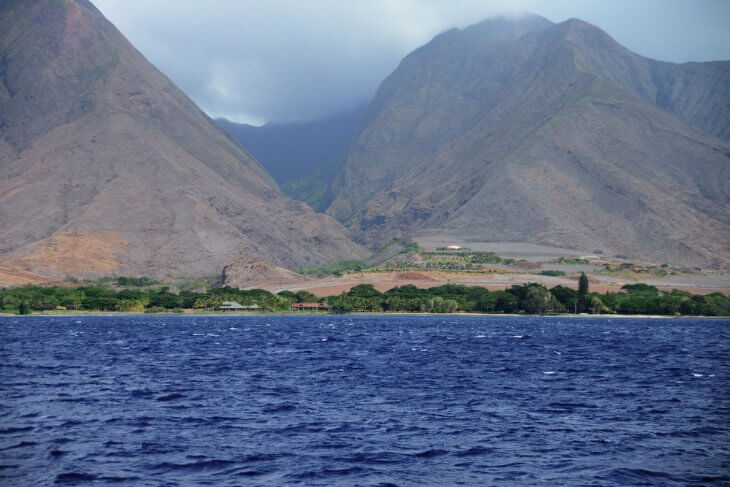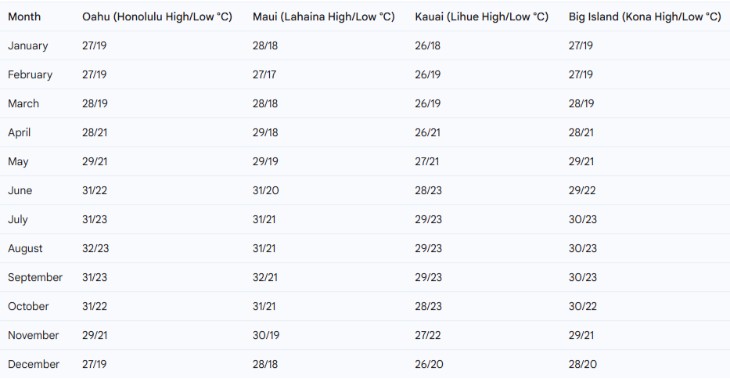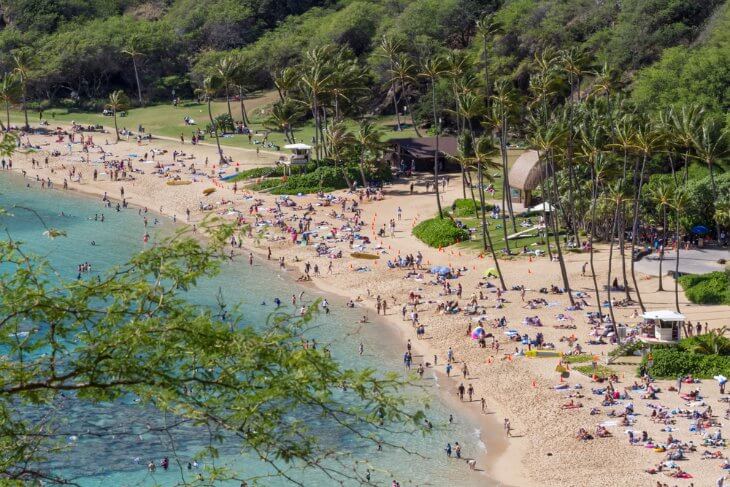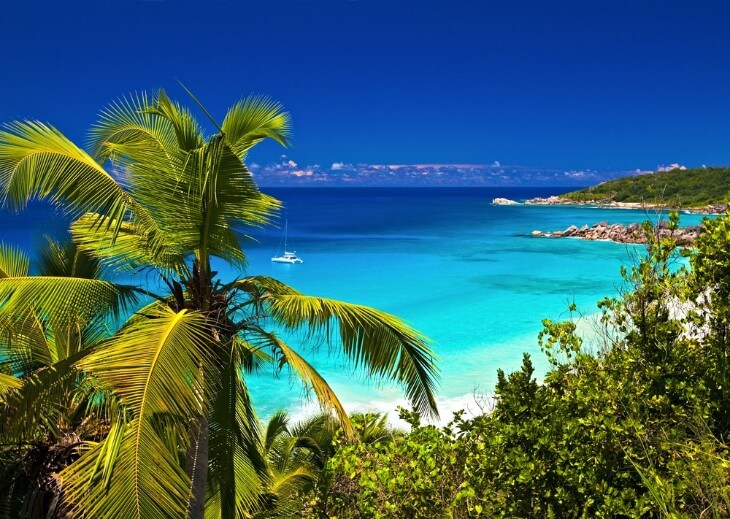Deciding on the perfect time for a Hawaiian getaway involves considering several factors, each holding different weight depending on what you're looking for in your vacation. While Hawaii's charm is constant year-round, subtle variations in weather, tourist numbers, and costs can significantly impact your overall experience. This guide offers a detailed look at these elements across the Hawaiian Islands to help you choose the most ideal period for your visit.
Hawaii's Climate: A Year-Round Overview
The Hawaiian Islands enjoy a remarkably stable tropical climate, with warm temperatures that vary minimally between seasons. During the summer months, from May to October, daytime highs at sea level typically range from 29 to 31 degrees Celsius. The winter period, from November to April, sees average daytime temperatures slightly cooler, between 26 and 28 degrees Celsius. Nighttime temperatures across the islands generally drop by approximately 5.5 to 8 degrees Celsius compared to the daytime highs. This consistent temperature suggests that other environmental factors might be more important to consider when planning your trip.
The traditional Hawaiian calendar recognizes two main seasons: Kau (summer) and Hooilo (winter). Kau, from May to October, is usually the drier and warmer of the two. Hooilo, from November to April, is generally associated with more rainfall, especially on the windward (northeastern) sides of the islands. This seasonal difference, based more on rainfall than significant temperature changes, means that if you prefer drier conditions, the Kau season might be better for your travels.
Prevailing northeasterly trade winds are a key factor in Hawaii's weather throughout the year. These winds, originating from high-pressure areas in the north Pacific, bring cooling breezes and moisture to the northeastern slopes of the islands. As these trade winds meet the mountainous terrain, they are forced upwards, causing the moisture to condense into clouds and produce rainfall, mainly on the windward sides. As a result, the leeward (southwestern) coasts of the islands tend to be much drier and sunnier. Several times a year, the typical trade wind pattern can be interrupted by what's known as Kona weather. During these times, the trade winds stop, and winds shift to come from the south or west, often bringing hot, humid, and sometimes stormy conditions. The regular trade winds provide a natural cooling effect, which can be especially welcome during the warmer summer months, while the less frequent Kona winds are a weather pattern some visitors might prefer to avoid.
Hawaii's diverse landscape, with volcanic mountains and deep valleys, creates many microclimates within relatively short distances. The Big Island, in particular, is known for having a wide range of climate zones. Rainfall amounts can vary greatly across an island; for example, Mount Waialeale on Kauai is one of the wettest places on Earth, while Kekaha, only about 32 kilometers to the southwest, receives much less rainfall. Additionally, temperatures drop significantly as altitude increases. These localized weather variations highlight the importance of researching the specific climate of the particular islands and regions you plan to visit, as general statements about Hawaiian weather may not always apply.

Monthly Weather Breakdown
For a more detailed understanding of the best time for a Hawaiian trip, a month-by-month analysis of key weather indicators is essential. The following tables show average monthly high and low temperatures and rainfall for representative locations across the four major Hawaiian Islands.

This data shows that August and September generally have the warmest temperatures across the Hawaiian Islands, while January and February tend to be the coolest.

Rainfall patterns vary significantly between islands and even within different parts of the same island. Generally, the winter months from November to March tend to be wetter across the state. However, leeward areas can remain relatively dry even during this period. Notably, Hilo on the Big Island consistently receives considerably more rainfall compared to Kona on the same island.
Humidity levels in Hawaii are typically higher during the summer months. Specific average monthly humidity data reveals the following trends: On Kauai, humidity ranges from 72% in September to 77% in December. Maui experiences a similar range, from 67% in June, July, August, and September to 73% in January and December. The Big Island's Kona region shows a more consistent humidity level, averaging around 65% to 67% throughout the year. Oahu has an average relative humidity of approximately 64%, with monthly averages fluctuating; for example, Honolulu's humidity ranges from 62% in June and July to 71% in January. While these humidity levels might seem high, the persistent trade winds often provide a comfortable breeze that reduces the feeling of humidity.
Surf conditions and water temperatures are also important factors in Hawaii's appeal. During the summer, the ocean waters are generally calm on all beaches. In contrast, the winter season brings powerful waves to the north shores of the islands due to storms in the Pacific, attracting experienced surfers from around the world. South-facing shores can also experience larger waves during the summer months, generated by storms in the southern hemisphere. East-facing shores often have choppier conditions due to the consistent trade winds. Despite these seasonal variations in wave action, the near-shore water temperatures remain comfortably warm throughout the year, typically ranging from 23 to 27 degrees Celsius.
Navigating Tourist Seasons and Crowd Levels
Understanding the patterns of tourist traffic is crucial for travelers seeking either a lively atmosphere or a more peaceful experience. Hawaii experiences distinct peak tourist seasons that can affect crowd levels and prices.
The winter months, from mid-December to March, are a significant peak season. This period is particularly busy around the Christmas and New Year holidays as people from colder climates, often called "snowbirds," seek warmth in Hawaii. Summer, spanning from June to August, is another major peak season, mainly due to families with school-aged children on summer break. Notably, July is often the most crowded month of the year. Additionally, the mid-spring period, around Easter break, can also see increased tourist numbers. These peak seasons typically have higher demand for flights and accommodations, potentially leading to increased prices and more crowded attractions.
In contrast to the busy peak seasons, the shoulder seasons, which include late spring (April-May) and fall (September-October), generally offer a good balance of pleasant weather and fewer tourists. The period following the winter holiday rush, encompassing late January and February, can also present opportunities for smaller crowds. These shoulder seasons often provide a more relaxed vacation atmosphere and potentially better deals on travel expenses.
The presence of major annual events and festivals can also influence tourist numbers in specific locations and at particular times. For instance, January sees events like the Ohana Festival and Sony Open on Oahu, and the Sentry Tournament of Champions on Maui. February features the Great Aloha Run on Oahu and the Maui Whale Festival. The Merrie Monarch Festival on the Big Island, a significant hula competition, takes place in March or April, often drawing considerable crowds. June hosts the statewide King Kamehameha Celebration and the Kapalua Wine & Food Festival on Maui. October brings the renowned Hawaii Food and Wine Festival, spanning multiple islands, and the Ironman World Championship on the Big Island. The Honolulu Marathon on Oahu occurs in December. Travelers interested in these specific cultural or sporting events should plan their visits accordingly, keeping in mind that these periods might experience higher tourist density. Conversely, those seeking a quieter vacation might wish to avoid destinations hosting major events during their intended travel dates.
The Ideal Time for Specific Activities
The optimal time to visit Hawaii can also depend on the specific activities you want to do.
For surfing enthusiasts, the north shores of all islands, particularly Oahu's famed North Shore, offer the most spectacular big wave conditions during the winter months, from November to February or March. Conversely, south-facing shores, such as Waikiki on Oahu and Poipu on Kauai, typically experience favorable surfing conditions during the summer months.
Whale watching is a popular activity in Hawaii, as humpback whales migrate to the warm waters from November to May to breed and calve. The peak season for observing these magnificent creatures is generally from January to March.
Travelers interested in hiking and other outdoor adventures might find the shoulder seasons of April-May and September-October particularly appealing. These periods often provide warm temperatures and lower rainfall in many regions. While winter can be suitable for hiking on leeward sides of the islands, windward areas might experience more frequent rain. Summer can be quite hot, especially at lower elevations, which might make strenuous hiking less comfortable.
For those prioritizing swimming and snorkeling, the summer months typically offer the calmest ocean conditions on most shores. Additionally, water temperatures tend to reach their warmest in late summer and early fall.
Considering Costs: Flights and Accommodation
The cost of a Hawaiian vacation, particularly flights and accommodation, can vary significantly depending on the time of year.
Generally, flight prices tend to peak during the high travel seasons, which include the winter holidays and the summer months, due to increased demand. Airfares can reportedly increase by as much as 30% during these peak periods. Conversely, the shoulder seasons of April-May and September-October often present opportunities for lower airfares, with potential savings of 20-40% compared to peak season rates. Some sources suggest that February, March, April, October, and November can also offer more affordable flight options. Booking flights well in advance, ideally several months prior to your travel dates, is generally recommended to secure better prices.
Accommodation costs, including hotels and vacation rentals, also fluctuate with seasonality, largely following the trends seen in flight prices. December is often cited as the most expensive month for hotel stays, while September may offer the most budget-friendly rates. The off-peak seasons, typically from mid-April to mid-June and September to mid-December, can see hotels offering discounts and promotions to attract guests. Vacation rentals, such as condos and houses, can sometimes provide more economical alternatives to hotels, particularly during peak travel periods.
To potentially reduce travel expenses to Hawaii, several strategies can be used. Traveling during the shoulder or off-peak seasons is often the most effective. Booking both flights and accommodations well in advance is generally advisable. Considering flexibility in travel dates and even the day of the week (with Tuesdays and Wednesdays sometimes offering better flight deals) can lead to savings. Exploring vacation rentals as an alternative to traditional hotels can also be beneficial. Finally, travelers should be mindful of potential additional costs such as resort fees and parking charges, which can add to the overall expense.

Island-Specific Considerations
While general trends exist across the Hawaiian Islands, each island has its own unique weather patterns and attractions that can influence the best time to visit.
Oahu generally experiences stable weather conditions. The Honolulu and Waikiki areas tend to be relatively dry, receiving an average of 508 to 1016 millimeters of rain annually. As the most popular island for first-time visitors, Oahu offers a diverse range of activities and historical sites. However, its popularity also means it experiences peak crowds during the winter and summer months, largely due to its primary international airport (HNL). The south shore, home to Waikiki, typically enjoys calmer waters during the summer, while the North Shore is world-renowned for its large waves in the winter.
Maui boasts a diverse array of microclimates, with the South Shore (including Kihei, Wailea, and Makena) and Central Maui (Kahului) being quite dry, while the Northeast coastline around Hana is significantly wetter. Popular attractions on Maui include its beautiful beaches, the scenic Road to Hana, and the majestic Haleakala National Park. Similar to Oahu, Maui experiences peak tourist seasons in winter and summer. The western coast around Kaanapali is generally drier compared to areas further north.
Kauai, often called the "Garden Isle," is known for its lush environment and higher overall rainfall, particularly on the North Shore encompassing Princeville and Hanalei. The South Shore, especially the Poipu area, tends to be the driest part of the island. Kauai is famous for its dramatic landscapes, including the stunning Na Pali Coast and the impressive Waimea Canyon. The winter months typically bring more rain to Kauai due to the prevailing trade winds. Travelers should also be aware of hurricane season, which runs from June to November, although major storms are historically rare around Kauai.
The Big Island (Hawaii Island) exhibits the most diverse weather patterns due to its significant size and varied topography, resulting in multiple distinct climate zones. The Kona side of the island is generally dry and sunny, while the Hilo side is considered the wettest major city in the United States. Higher elevations, such as Volcano and Mauna Kea, experience considerably cooler temperatures. The Big Island offers unique attractions like active volcanoes and exceptional stargazing opportunities. Its peak tourist seasons generally align with the broader trends across the Hawaiian Islands.
Conclusion: Determining Your Best Time to Visit
Ultimately, the "best" time to visit Hawaii is a personal decision that depends on your individual priorities and preferences.
For travelers prioritizing optimal weather conditions, the shoulder seasons of April-May and September-October often offer an ideal balance, with warm, sunny days and lower rainfall in many areas. Summer (June-August) guarantees warmth and sunshine, but visitors should be prepared for higher humidity levels and the possibility of Kona winds.
Those seeking to minimize crowds should also consider the shoulder seasons, along with the periods immediately following the winter holidays (late January-February) and just before the summer rush (late April-May). It's also wise to be aware of specific events that might attract larger numbers of tourists.
For the best value, considering the interplay between weather and cost, the shoulder seasons frequently emerge as the most advantageous. These periods typically offer pleasant weather with the potential for lower prices on both flights and accommodations.
It is crucial for prospective visitors to conduct specific research on the particular islands and even regions within those islands that they plan to visit, taking into account their desired activities and weather preferences. Hawaii offers a remarkable and diverse travel experience throughout the year, and a nuanced understanding of these seasonal variations will empower you to choose the time that best aligns with your individual needs and aspirations.
Sources:
Hawaii Tourism Authority: https://www.hawaiitourismauthority.org/research/reports/
US Climate Data: https://www.usclimatedata.com/climate/honolulu/hawaii/united-states/ushi0026
Hawaii Guide: https://www.hawaii-guide.com/big-island/big-island-weather
Maui Hawaii: https://www.mauihawaii.org/rain-maui-rainfall/
Time and Date: https://www.timeanddate.com/weather/@5848511/climate
Weather 2 Travel: https://www.weather2travel.com/hawaii/honolulu-oahu/climate/
Weather World: https://www.weatherworld.com/climate-averages/hi/oahu.html
Wikipedia: https://en.wikipedia.org/wiki/Climate_of_Hawaii
Hawaii Gaga: https://www.hawaiigaga.com/WeatherGuide.aspx
Volcano Hawaii: https://volcano-hawaii.com/tourists-pick-the-wrong-time-to-visit-big-island-hawaii/


